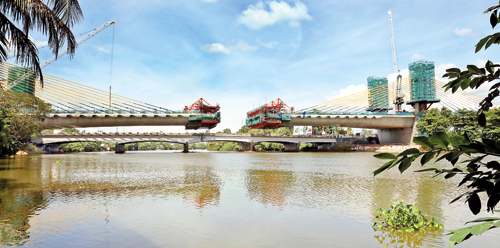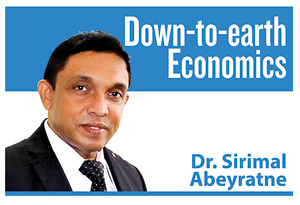Building and economic construction in Sri Lanka
View(s):
File picture of the new Kelani Bridge which is almost completed.
We have seen many condominiums and shopping malls in Colombo. When you enter the ground floor or basement areas of such buildings, perhaps you would have noticed a giant power generator. Apart from its capital cost and operational cost, it occupies a considerable and valuable part of the space of these buildings; if they are in operation the noise and vibration is overwhelming too. Since I haven’t seen anything as such added to the condominiums and shopping malls in any other country – at least in the countries that I have visited, the power generators here in condominiums and shopping malls look quite bizarre to me.
Construction bubbles
Two weeks ago, I had to speak on “Construction Industry and the Economy” at a webinar organised by the Construction Sector Committee of the Organisation of Professional Associations (OPA). As I had a couple of communications with the Chairman of this Committee, Architect Rohana Herath, I posed a few questions to him.
I asked him: “Is it necessary to install power generators in the big buildings?”
He answered: “In Sri Lanka, it’s a must! We can’t have a big building without it, because continuous electricity supply is not certain.”
My speech and the discussion followed by that inspired me to write on some interesting aspects of the construction industry and its link with economic progress. A “subdued” construction industry is a bottleneck to economic growth; even the “over-sized” construction industry could be an equally important bottleneck to economic growth.
Construction booms too can sometimes be transformed into what are called “construction bubbles” or “real estate bubbles” or “housing bubbles”. While the “bubbles” burst at the end, the most recent burst in the world was seen in 2008 which fueled the US Financial Crisis.
Construction bubbles are a result of excess demand for the industry, which would cause its disproportionate increase in real estate prices with an end result of a collapse. Excess demand could be caused by many factors including speculation, while the government policies as well as public perception over interest rates and inflations rates can fuel it.
Tradable and non-tradable sectors
An entire production activity of a country could be split into two as ‘tradable’ and ‘non-tradable’ sectors. This distinction is a crucial point to understand the construction industry from an economic point of view and its role in a country’s economic growth, income generation and job creation.
Tradable sectors are those which produce goods and services that can be traded internationally; they include manufactured goods, agricultural produce, and a wide range of services such as banking, insurance, consulting, ICT services, R&D, and customer service. These goods and services can be produced in one country and sold to the customers in another country so that there would be “trade across the borders”.
 The output of non-tradable sectors cannot be traded internationally so that their products should be sold only within the country where they are produced; the output of the construction industry is a non-tradable commodity! In general, the construction industry comprises “building construction” such as residential facilities, office buildings, factories and shopping malls as well as “infrastructure construction” such as roads, bridges, airports and seaports. We cannot sell them or use them across the borders of the country where they are produced and, hence they carry the title non-tradable sectors.
The output of non-tradable sectors cannot be traded internationally so that their products should be sold only within the country where they are produced; the output of the construction industry is a non-tradable commodity! In general, the construction industry comprises “building construction” such as residential facilities, office buildings, factories and shopping malls as well as “infrastructure construction” such as roads, bridges, airports and seaports. We cannot sell them or use them across the borders of the country where they are produced and, hence they carry the title non-tradable sectors.
Public administration, health care, transport, hospitality, port services, and aviation services are all examples of non-tradable sectors. Distribution of gas, electricity and water is a non-tradable commodity for some countries, while they can be treated as tradable commodities in some other countries which decide to trade them across the borders as well. This means that some of the sectors may fall under both categories too.
Long-term growth
Economic growth of a country – which is the road to prosperity, can be sustained over a longer period of time only if that country maintains an appropriate balance between the tradable and non-tradable sectors. In fact, it is because of this reason, we need to look at the link between the construction industry and the economy.
Many of the non-tradable sectors such as the construction industry is a vital “input” to the tradable sectors (apart from being inputs to consumption as well). If you consider building construction, all building output is either for residential facilities (consumption) or for business facilities (production). If you take infrastructure construction, it also provides an important service input to produce all other economic activities.
What is the point? The point is a country can produce a disproportionately large output from construction industry, but if that output is not utilised as inputs to produce tradable output the economy is deemed to slow down; together with that income generation and job creation would come to a halt as well, while there will be a declining demand for the construction industry as well.
Even to finance the construction industry, the resources need to be generated from a vibrant growth process of a tradable sector. All the materials that are used in the construction industry are tradable so that, as we know some of the materials are produced domestically while some are imported. This is why the export growth which is emanating from the output of the tradable sector is important for sustaining long-term economic growth of a country as well as the growth of its construction industry itself.
Not for trade
 By the way, even without a long-term economic growth emanating from the tradable sector, a country can engage in building construction and infrastructure construction, financed through domestic or foreign borrowings either by the private sector or the public sector. If it is not linked to generate output from the tradable sector, the economic expansion is bound to slow down. As a result, there may be condominiums without residents, shopping malls without shops, conference halls without people, highways without vehicles, seaports without ships and, airports without planes!
By the way, even without a long-term economic growth emanating from the tradable sector, a country can engage in building construction and infrastructure construction, financed through domestic or foreign borrowings either by the private sector or the public sector. If it is not linked to generate output from the tradable sector, the economic expansion is bound to slow down. As a result, there may be condominiums without residents, shopping malls without shops, conference halls without people, highways without vehicles, seaports without ships and, airports without planes!
Let me elaborate my point by taking Sri Lanka’s growth scenario over the period after 2009, i.e. since the end of the conflict. We all remember that the country had a very high rate of GDP growth, which was over 8 percent, during the first three years, 2010-2012. Among other things, this post-war high growth was made possible by the expansion of the “non-tradable” sector including the overwhelming construction and the reconstruction activities at the time. However while it was not accompanied by a corresponding expansion of the tradable sector which was already on a slowdown path; the long-term rate of economic growth began to slow down too.
How do we know that the rapidly expanding non-tradable sector did not generate inputs to long-term growth from the tradable sector? It is because a slowdown in export growth was already visible since the turn of the Century, while there was no private investment growth in the tradable sector. Even after the end of the conflict in 2009, Sri Lanka failed to establish an attractive investment climate in the country.
Beware of input costs
I have another important point to highlight: The prices of the non-tradable sector are determined exclusively by the domestic factors – material costs, labour costs, land prices, government taxes, regulatory bottlenecks and the internal inefficiencies; even the “power generator” installed in a building is an additional cost to the clients and to their businesses. This means that the input costs of the non-tradable sector play an important role in the cost advantage of the tradable sector, which has to be cost competitive internationally.
In conclusion, I have an important point to emphasise: There is no need to be overjoyed by a random higher rate of economic growth if it is not accompanied by corresponding export growth.
(The writer is a Professor of Economics at the University of Colombo and can be reached at sirimal@econ.cmb.ac.lk and follow on Twitter @SirimalAshoka).


